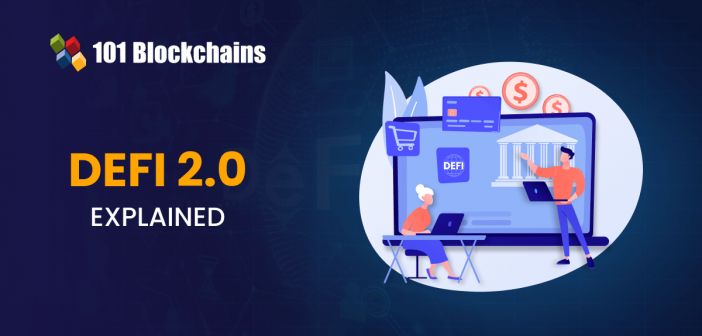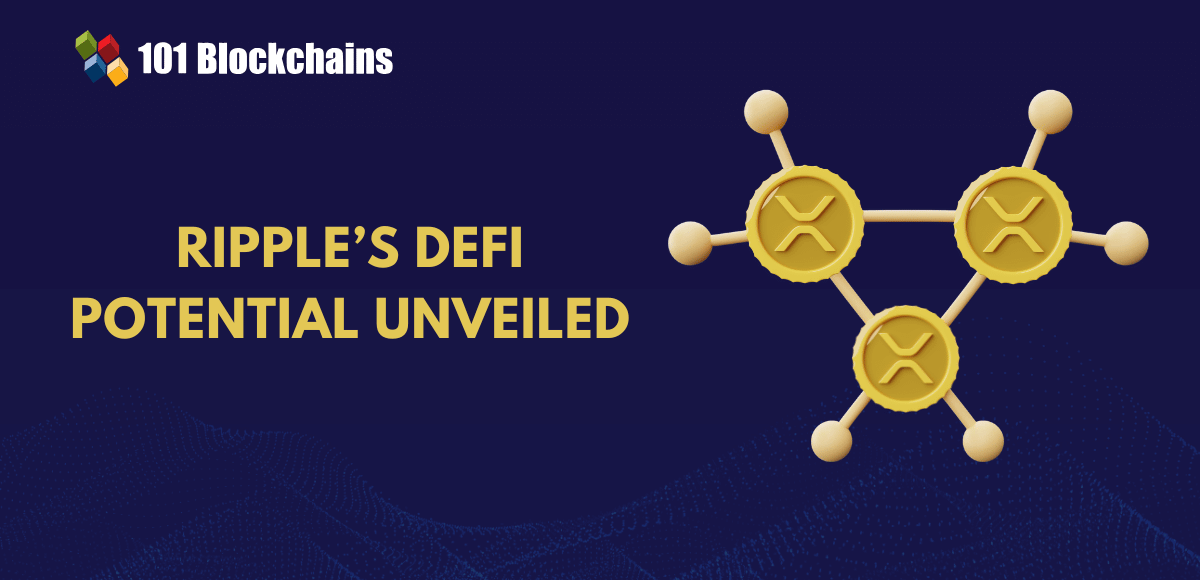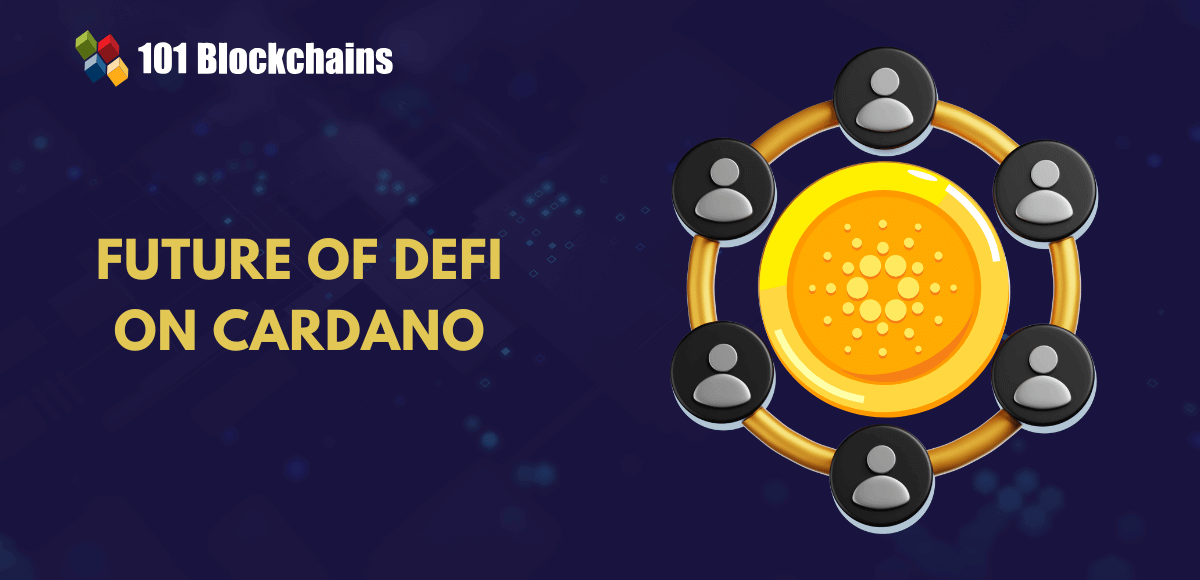Learn how blockchain truly works, master key definitions, and uncover what makes smart contracts so "smart." Dive into the fundamentals, gain valuable insights, and start your blockchain journey today!

- Decentralized Finance
Georgia Weston
- on June 20, 2022
DeFi 2.0 – A Comprehensive Guide
Decentralized finance (DeFi), is one of the most significant examples of blockchain-based innovation in recent times. DeFi broke down the barriers to access to traditional financial services with an extended assortment of decentralized applications. The primary aim of DeFi focused on removal of intermediaries in the traditional financial services for setting new benchmarks in access to financial services. At the same time, talks regarding “What is DeFi 2.0” have emerged as a prominent highlight in the evolution of decentralized finance. DeFi protocols go through continuous evolution alongside improving on the existing models of agreements in the domain of financial services.
Is DeFi 2.0 the next stage of decentralized finance or just a term coined for hyping decentralized finance services? You can find an answer in the possibilities for improvements in decentralized finance with DeFi 2.0 solutions. The following discussion offers you an introductory guide on DeFi 2.0 with an overview of background of DeFi developments. You can also discover the setbacks with DeFi 1.0, which established the foundation for DeFi 2.0 solutions, along with an example.
Want to explore an in-depth understanding of security threats in DeFi projects? Enroll in DeFi Security Fundamentals Course Now!
What is the Need of DeFi 2.0?
If you want to learn about DeFi 2.0 projects, then you must start with a detailed understanding of the timeline leading to DeFi 2.0. The pioneer DeFi protocols such as Uniswap, Compound, and MakerDAO established an ideal playground for the thriving DeFi ecosystem. Some of the early players in the decentralized Automated Market Maker or AMM space, as well as DeFi applications such as Uniswap, enable the facility for users to swap tokens without leaving custody. Compound and Aave served as decentralized lending and borrowing platforms with facility for on-chain yield on deposits alongside permissionless access to operating capital. On the other hand, MakerDAO introduced a decentralized stablecoin.
Seems like everything is alright with DeFi projects, isn’t it? It is reasonable to wonder about questions like “What is the need of DeFi 2.0?” and the answers draw the limelight on the working of DeFi services. The evolution of DeFi 2.0 protocols starts from the limitations of existing DeFi models. For example, the infrastructure underlying different DeFi protocols offers considerably different advantages in transparency and user control in comparison to centralized companies. On the other hand, the innovation in DeFi protocols depends on the technological advancements behind the services. The limitations of the existing DeFi model are largely associated with the components behind every service.
Want to learn and understand the scope and purpose of DeFi? Enroll Now in Introduction to DeFi- Decentralized Finance Course
Challenges with DeFi 1.0
The existing model of decentralized finance or DeFi 1.0 set a new precedent for decentralization of financial services. However, the second generation of decentralized finance emerged as a necessary response to the existing flaws in DeFi 1.0. Here is an overview of the notable limitations of DeFi 1.0.
-
Liquidity Mining
Various DeFi protocols do not offer long-term and reasonable incentives for liquidity providers other than distribution of LP tokens. Generally, liquidity providers withdraw allocated resources and rewards on a routine basis. The periodic sale of the native tokens of DeFi protocols ultimately leads to dilution of the supply.
-
Liquidity
The majority of DeFi solutions require liquidity, and it depends on a lock-up of funds and the total value of assets. When you think of the assets spread throughout different blockchain networks and markets, you can notice the impact of financial rigidity. Therefore, one of the basic foundations of DeFi 1.0 protocols, i.e., liquidity, sets a reason for introducing DeFi 2.0 crypto to resolve the problems of capital inefficiency.
-
Security
The next crucial limitation of DeFi 1.0 refers to security, which emerges due to routine upgrades and modifications in software. It is important to note that even the most credible DeFi security companies have offered redundant and outdated information. In addition, many DeFi users don’t have any idea regarding secure risk management or objective validation of network security. Considering the massive volume of funds locked up in DeFi protocols, security is an obvious necessity and glaring problem for DeFi 1.0 projects.
-
Scalability
The most prominent reason for introducing improvements in decentralized finance with DeFi 2.0 refers to scalability issues. The majority of DeFi solutions encounter the problems of data congestion during peak network activity periods. Data congestion in DeFi 1.0 protocols generally end up slowing down the transaction speed alongside increasing the network fees.
-
Oracles
The effectiveness of the existing DeFi model depends considerably on the use of external information through oracles. As a matter of fact, oracles are just third-party data sources. Therefore, the integrity of information offered by Oracles can have huge implications on DeFi users and the protocol itself.
-
Centralization
The final and most noticeable challenge with DeFi 1.0 protocols, which creates the foundation for DeFi 2.0 projects, refers to centralization. Decentralized finance projects are not immune to the blockchain trilemma as they have to compromise with decentralization to ensure higher security and scalability.
The background of the problem with DeFi projects and limitations in the existing DeFi model offers the right canvas for painting a clear picture of DeFi 2.0.
Want to explore in-depth about DeFi protocol and its use cases? Enroll in Decentralized Finance (Defi) Course- Intermediate Level Now!
What is DeFi 2.0?
The obvious question that must have been running through your mind is the definition of DeFi 2.0 does not come as a surprise. It is basically the second generation of decentralized finance protocols aimed at clearing the flaws in the first DeFi iteration. Almost any individual with a crypto wallet could obtain access to decentralized finance services. However, DeFi 1.0 has a specific set of limitations, which DeFi 2.0 aims to resolve with an innovative concept. DeFi 2.0 would leverage Protocol-Controlled Liquidity or PCL protocols for resolving the problems of liquidity.
The focus of the new DeFi 2.0 in crypto would evolve with a business-to-business or B2B model orientation. Interestingly, the first generation of decentralized finance products has strengthened the foundations of the industry through a strong user base. In addition, early DeFi solutions also established some crucial benchmarks for enabling future developers to create new DeFi solutions. As of now, the primary goal of DeFi 2.0 focuses on protection for the long-term viability of decentralized finance.
Want to understand the best ways to use DeFi development tools like Solidity, React, and Hardhat? Enroll now in DeFi Development Course!
Aim of DeFi 2.0
As stated already, the basic objective of DeFi 2.0 protocols rounds up on resolving the existing issues with DeFi 1.0. Most important of all, DeFi 2.0 would focus on ensuring that the DeFi movement carries on. Decentralized finance relies on third-party providers alongside token incentives for ensuring liquidity. At the same time, DeFi does not have any correlation to traditional finance or the global economy.
These problems can create substantial setbacks for the sustainability of decentralized finance over the long run. DeFi 2.0 and the other improvements following it would focus on resolving these issues. The early examples of DeFi 2.0 projects such as OlympusDAO present innovative solutions for ensuring long-term liquidity. In addition, the protocol-controlled value mechanisms with DeFi 2.0 can also help in empowering DAOs.
Learn the fundamentals of Decentralized Finance (DeFi) with DeFi Flashcards!
Technology and Innovation behind DeFi 2.0
The limitations of DeFi 1.0 obviously provided the rationale for DeFi 2.0. At the same time, the goals of DeFi 2.0 showcase promising details regarding the technology improvements for resolving the problems with DeFi 1.0. However, it is important to learn how DeFi 2.0 works. What are the technologies driving the transition towards DeFi 2.0? Here are the notable solutions which have supported the growth of DeFi 2.0.
-
Scalability
DeFi users have to counter formidable issues in engaging with the Ethereum network, especially beginners. On the other hand, many users don’t have the opportunity to access DeFi services, owing to long wait times and the high gas prices. How can DeFi 2.0 protocols resolve this problem? One of the first answers might draw attention to alternatives to Ethereum such as BSC, Solana, or Polygon. These blockchain networks can offer the benefit of layer 2 scalabilities and drive the adoption of DeFi solutions. As a matter of fact, the next wave of DeFi solutions would focus profoundly on the issues of scalability.
-
Centralization
The widespread interest in DeFi revolves largely around the potential for lucrative money-generating opportunities. On the other hand, it is important to note that DeFi is also an alternative for some users to have financial independence and self-sufficiency. However, you cannot find the same in the existing model of decentralized finance solutions. The advancements in decentralized finance with DeFi 2.0 would ensure decentralization for users as a top priority. Existing DeFi solutions feature groups that have control over the whole protocol, thereby creating doubts regarding their integrity. The evolution of Decentralized Autonomous Organizations or DAOs in recent times offers vital advantages for improving DeFi models. DAOs can resolve the centralization aspect by placing the governance of a protocol in the hands of the user community.
-
Liquidity Mining
Liquidity mining is also another important factor underlying the growth of DeFi 2.0 in crypto, especially with the massive growth in DeFi activity in 2020. Yield farming or liquidity mining offered a solid foundation for new DeFi protocols. DeFi 2.0 could now develop on the massive volumes of liquidity for launching and sustaining operations, alongside minimizing slippage. As a matter of fact, yield farming offers the best tool for obtaining the necessary funds for DeFi projects. At the same time, DeFi 2.0 projects must also take note of the concerns in long-term yield farming and token supply to avoid consequences.
Become a member now to watch our on-demand webinar on DeFi And The Future Of Finance
Examples of DeFi 2.0 Protocols
OlympusDAO is one of the first examples of a DeFi 2.0 solution. The decentralized currency reserve protocol with the native token, OHM, and the support of a collection of assets with Olympus Treasury. As one of the prominent examples of a solution for decentralized finance in DeFi 2.0, OlympusDAO aims to create a policy-guided currency system with the help of the DAO to ensure management of native tokens. OlympusDAO deals with bonds in the same structure as that of a discounted token sale. Rather than receiving interest, investors can sell their assets to the Olympus Treasury in exchange for OHM tokens at a discounted rate. Investors must stake their discounted OHM for receiving plausible returns unless the token registers any price appreciation.
Olympus features a wide range of bond types according to the ROI share. Some of the notable examples of bonds by Olympus include,
- FRAX bond
- DAI bond
- wETH bond
- OHM-FRAX LP bond
- OHM-DAI LP bond
The identity of OlympusDAO as a pioneer in DeFi 2.0 protocols stands strong with its exceptional structure. Estimates suggest that the OlympusDAO protocol has ownership and management privileges over 99% of the liquidity in the OHM-DAI bond. OlympusDAO protocol relies on the DAO for high-level internal control and management of the structure to ensure freedom from capital inefficiencies alongside instability with OHM tokens.
Start learning Decentralized Finance (DeFi) with World’s first DeFi Skill Path with quality resources tailored by industry experts Now!
Benefits of DeFi 2.0
The overview of the foundations of DeFi 2.0 alongside the technologies which enable it shows how it is necessary now. What are the value advantages of the second generation of decentralized finance for users? Here is an outline of the notable beneficial use cases of DeFi 2.0.
-
Broader Flexibility for Asset Staking
DeFi 2.0 provides a vital improvement over the incentives for DeFi 1.0 users with yield farming. Even if users received LP tokens for staking their assets in a liquidity pool, the value of the assets locked up continued increasing. DeFi 2.0 projects can help in introducing new layers of incentives and utilities through investing LP tokens as collateral for loans. The LP tokens can also work for minting additional tokens, as you would find in the case of MakerDAO.
-
Safety against Impermanent Loss
Changes in price ratios can have a negative impact on users investing in liquidity pools by using liquidity mining. DeFi 2.0 protocols are working on development of new methods for resolving the risks of impermanent loss. DeFi 2.0 users have to work with the protocol for creating token pairs. If one user adds a token to the liquidity pool, the protocol would also add the native token for balancing the pair. It is important to note that the user and the protocol can receive fees for the swaps associated with the concerned pair. The protocol can use the fees generated for creating an insurance fund to safeguard against impermanent loss.
-
Insurance-backed Smart Contracts
Another interesting use case of DeFi 2.0 would point at insurance-backed smart contracts. DeFi works on the principles of transparency and features an open-source infrastructure. Therefore, people with limited technical experience can face considerable difficulties in addressing due diligence and risk assessment for DeFi protocols and smart contracts. Now, DeFi 2.0 crypto can resolve the issue with insurance on smart contracts, which can provide guarantees for a user’s deposits in return for a fee. As of now, such platforms are under development and have to depend profoundly on configuration of smart contracts.
Become a member now to watch our on-demand webinar on Bridging Traditional Finance With DeFi
Bottom Line
The specific concerns regarding the existing decentralized finance models present various implications for users and developers. Apart from the basic answers for “What is DeFi 2.0?” it is important to look beyond and find out the possibilities for improvements. The basic objective of DeFi 2.0 with the improvements over existing DeFi 1.0 solutions is the resolution of setbacks with DeFi 1.0.
At the same time, DeFi 2.0 aims to fuel the growth of decentralized finance in the future. DeFi 2.0 resolves many notable concerns associated with existing DeFi models, such as scalability and barriers to access. On top of it, DeFi 2.0 solutions have the potential to introduce the actual ‘decentralization’ in DeFi services. Learn more about DeFi and how DeFi 2.0 is more relevant than ever.
*Disclaimer: The article should not be taken as, and is not intended to provide any investment advice. Claims made in this article do not constitute investment advice and should not be taken as such. 101 Blockchains shall not be responsible for any loss sustained by any person who relies on this article. Do your own research!



![30+ Best Decentralized Finance Applications [Updated] best decentralized finance (DeFi) applications](https://101blockchains.com/wp-content/uploads/2020/10/decentralized-finance-applications.png)

